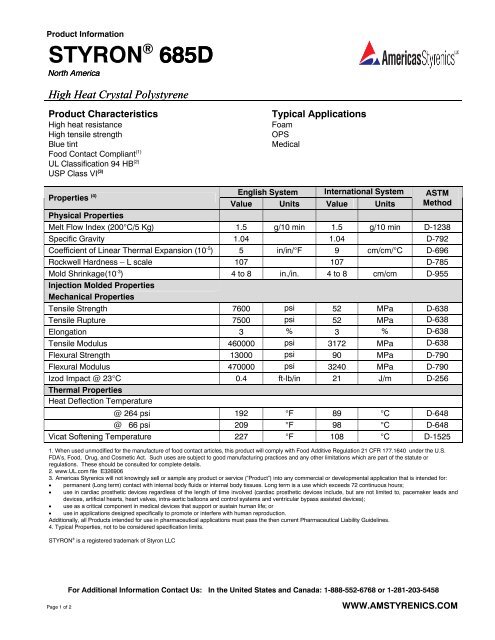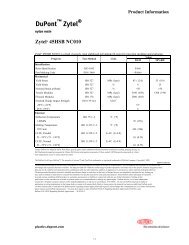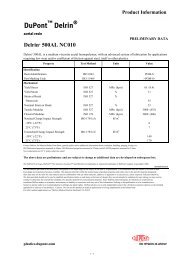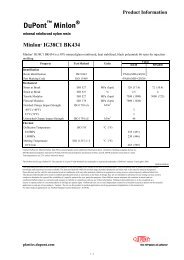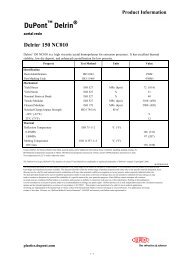styron® 685d - Promaplast
styron® 685d - Promaplast
styron® 685d - Promaplast
You also want an ePaper? Increase the reach of your titles
YUMPU automatically turns print PDFs into web optimized ePapers that Google loves.
Product Information<br />
STYRON ® 685D<br />
North America<br />
High Heat Crystal Polystyrene<br />
Product Characteristics<br />
Typical Applications<br />
High heat resistance<br />
Foam<br />
High tensile strength<br />
OPS<br />
Blue tint<br />
Medical<br />
Food Contact Compliant (1)<br />
UL Classification 94 HB (2)<br />
USP Class VI (3) English System International System<br />
Properties (4) Value Units Value Units<br />
ASTM<br />
Method<br />
Physical Properties<br />
Melt Flow Index (200°C/5 Kg) 1.5 g/10 min 1.5 g/10 min D-1238<br />
Specific Gravity 1.04 1.04 D-792<br />
Coefficient of Linear Thermal Expansion (10 -5 ) 5 in/in/°F 9 cm/cm/°C D-696<br />
Rockwell Hardness – L scale 107 107 D-785<br />
Mold Shrinkage(10 -3 ) 4 to 8 in./in. 4 to 8 cm/cm D-955<br />
Injection Molded Properties<br />
Mechanical Properties<br />
Tensile Strength 7600 psi 52 MPa D-638<br />
Tensile Rupture 7500 psi 52 MPa D-638<br />
Elongation 3 % 3 % D-638<br />
Tensile Modulus 460000 psi 3172 MPa D-638<br />
Flexural Strength 13000 psi 90 MPa D-790<br />
Flexural Modulus 470000 psi 3240 MPa D-790<br />
Izod Impact @ 23°C 0.4 ft-lb/in 21 J/m D-256<br />
Thermal Properties<br />
Heat Deflection Temperature<br />
@ 264 psi 192 °F 89 °C D-648<br />
@ 66 psi 209 °F 98 °C D-648<br />
Vicat Softening Temperature 227 °F 108 °C D-1525<br />
1. When used unmodified for the manufacture of food contact articles, this product will comply with Food Additive Regulation 21 CFR 177.1640 under the U.S.<br />
FDA’s, Food, Drug, and Cosmetic Act. Such uses are subject to good manufacturing practices and any other limitations which are part of the statute or<br />
regulations. These should be consulted for complete details.<br />
2. www.UL.com file E326906<br />
3. Americas Styrenics will not knowingly sell or sample any product or service (“Product”) into any commercial or developmental application that is intended for:<br />
• permanent (Long term) contact with internal body fluids or internal body tissues. Long term is a use which exceeds 72 continuous hours;<br />
• use in cardiac prosthetic devices regardless of the length of time involved (cardiac prosthetic devices include, but are not limited to, pacemaker leads and<br />
devices, artificial hearts, heart valves, intra-aortic balloons and control systems and ventricular bypass assisted devices);<br />
• use as a critical component in medical devices that support or sustain human life; or<br />
• use in applications designed specifically to promote or interfere with human reproduction.<br />
Additionally, all Products intended for use in pharmaceutical applications must pass the then current Pharmaceutical Liability Guidelines.<br />
4. Typical Properties, not to be considered specification limits.<br />
STYRON ® is a registered trademark of Styron LLC<br />
For Additional Information Contact Us: In the United States and Canada: 1-888-552-6768 or 1-281-203-5458<br />
Page 1 of 2<br />
WWW.AMSTYRENICS.COM
Typical Processing Conditions<br />
Injection Molding<br />
Typical Molding Machine Settings<br />
Zone International System English System<br />
Nozzle 230 - 245 ° C 445 - 470 ° F<br />
Zone # 1 230 - 245 ° C 445 - 470 ° F<br />
Zone # 2 215 - 230 ° C 420 - 470 ° F<br />
Zone # 3 200 - 215 ° C 390 - 420 ° F<br />
Back Pressure 2 - 15 bar 25 - 215 psi<br />
Mold Temperatures<br />
High mold temperatures produce higher surface gloss and<br />
minimize flow marks and weld lines. Orientation is also<br />
reduced, thereby improving the properties of the part.<br />
However, high mold temperatures can require longer cycles<br />
in order to set up the polymer. Low mold temperatures are<br />
used for faster cycles. The parts will lack gloss, have poorer<br />
weld lines and a higher level of molded-in stress.<br />
Recommended mold surface temperatures for polystyrene<br />
range from 60º to 150º F. Use the highest temperature<br />
possible where you can maintain the desired cycle time.<br />
Feed Fill Rate Screw Forward<br />
The feed control should be adjusted to<br />
equal the desired shot weight. A general<br />
rule of molding parts with a minimum<br />
amount of internal stress and free of sink<br />
marks is to adjust the feed to keep the<br />
plunger from bottoming out. The feed<br />
Fast fill rates generally provide better<br />
uniformity in part size and quality.<br />
Rapid fill rates are possible if gate sizes<br />
and locations are properly selected.<br />
Gates too small for a particular part<br />
thickness can cause problems when<br />
Screw forward time should be controlled to<br />
prevent the plastic from flowing into or<br />
back from the cavity. Screw forward time<br />
is a function of mold and material<br />
temperature, part thickness, gate and<br />
runner size. Decreasing screw forward<br />
should be adjusted to give a cushion of filled at rapid speeds. Use the fastest time increases part shrinkage.<br />
about ¼ inches. A larger cushion should fill rate the mold design and part will Allowances must be made in the screw<br />
be used only if the material contains tolerate understanding that not all forward time and hold pressure to<br />
moisture, air and/or excessive volatile applications can tolerate a fast fill rate. minimize shrinkage and sink marks.<br />
content that show up as silver or black Heavy section parts require a slow fill to Excessive screw forward time can overpack<br />
the runner system or sprue, causing<br />
streaks in the molded part.<br />
avoid flow and weld marks on the<br />
surface of the part.<br />
sticking.<br />
Extrusion<br />
Typical Extruder Settings<br />
Zone International System English System<br />
Zone # 1 177 - 193 ° C 350 - 380 ° F<br />
Zone # 2 182 - 204 ° C 360 - 400 ° F<br />
Zone # 3 188 - 210 ° C 370 - 410 ° F<br />
Zone # 4 199 - 216 ° C 390 - 420 ° F<br />
Zone # 5 204 - 221 ° C 400 - 430 ° F<br />
Zone # 6 204 - 221 ° C 400 - 430 ° F<br />
Melt Pump,<br />
Adapter, Pipes, 193 - 232 ° C 380 - 450 ° F<br />
Screen Changer<br />
Die 199 - 232 ° C 390 - 450 ° F<br />
Polish Rolls 66 - 104 ° C 150 - 220 ° F<br />
Melt<br />
Temperature<br />
193 - 232 ° C 380 - 450 ° F<br />
Head Pressure 10 - 21 MPa 1500 - 3000 psi<br />
Extrusion Conditions<br />
A lower temperature value within the typical temperature<br />
range denotes usage of the material with a styrene butadiene<br />
block copolymer in impact-modified blends. A screw design<br />
with a mixing head and a compression ratio of roughly 4:1 or<br />
a static mixing device is recommended for proper dispersion<br />
when using colorants or other additives.<br />
The extruder die should be set from 110-150% of the required<br />
sheet thickness. The first polish roll gap should be set<br />
roughly 95% of the finished sheet thickness while the second<br />
polish roll gap can be set greater than or equal to 100% of the<br />
sheet thickness depending on what surface needs to be<br />
imparted upon the sheet by the final roll.<br />
For all polystyrene products except OPS, the sheet<br />
orientation should not exceed 30%. Brittleness and tear<br />
strength of the sheet, especially in the machine direction, is<br />
drastically deteriorated at orientation levels >30%.<br />
Recommended temperatures are typical ranges only.<br />
Product Stewardship: Americas Styrenics is committed to product stewardship and urges all users of its products to take appropriate steps to protect employee<br />
health, public health and our environment during the use of its products. Successful product stewardship rests with every individual involved with Americas Styrenics’<br />
products – from initial concept and research, to manufacture, distribution, use, and disposal of the products.<br />
Customer Notice: Before using this product, the user is strongly advised to conduct an assessment of the safety and suitability of the product for the specific use in<br />
question and is further advised against relying solely on the information contained herein as it may relate to a specific use or application.<br />
Americas Styrenics does not endorse or claim suitability of its products for specific medical applications. We request that customers considering the use of Americas<br />
Styrenics products in medical applications notify Americas Styrenics such that the appropriate assessments may be conducted. It is the ultimate responsibility of the<br />
user to ensure that the product is safe, lawful and technically suitable for the user’s specific application.<br />
Disclaimer: Americas Styrenics Company LLC does not make, and expressly disclaims, all warranties, including warranties of merchantability or fitness for a<br />
particular purpose, regardless of whether oral or written, express or implied, or allegedly arising from any usage of any trade or from any course of dealing in<br />
connection with the use of the information contained herein or the product itself. The user expressly assumes all risk and liability, whether based in contract, tort or<br />
otherwise, in connection with the use of the information contained herein or the product itself. Further, information contained herein is given without reference to any<br />
intellectual property issues, as well as federal, state or local laws which may be encountered in the use thereof. Such questions should be investigated by the user.<br />
For Additional Information Contact Us: In the United States and Canada: 1-888-552-6768 or 1-281-203-5458<br />
Page 2 of 2 January 2011 WWW.AMSTYRENICS.COM


